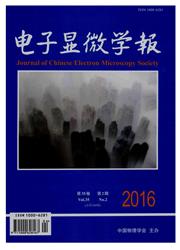

 中文摘要:
中文摘要:
利用电子探针分析,背散射形貌分析和元素面分布及定量分析等手段,对陕西省平利县朱家院碱性岩中的易解石进行了研究。结果表明:朱家院碱性岩中易解石主要有不规则粒状和细脉状两种产状,粒状易解石粒径在10~100μm,常与金红石、钠铁闪石等矿物伴生;脉状易解石切割脉状褐帘石,显示脉状易解石为后期形成。两种易解石中Nb,Ta,Ti,Ce,Nd等元素分布均均匀;稀土含量相对较高,有富轻稀土,贫重稀土的特征,其中Ce和Nd的含量高。脉状易解石中Nb,Ta含量高于粒状易解石,Ti含量低于后者;根据成分确定,脉状易解石为铌易解石,粒状易解石为易解石-铌易解石过渡型。
 英文摘要:
英文摘要:
The aeschynite from alkaline trachyte in Zhujiayuan of Pingli county, Shanxi province was studied using electron microprobe analysis, back scattering morphology, element distribution and quantitative analysis methods. The results show that the aeschynite has irregular granular and fine vein two main occurrences, and the irregular granular aeschynite is in particle size from 10 to 100 μm and usually accompanies with rutile and arfvedsonite. The fine vein aeschynite cuts the nervation allanite, and it shows that the fine vein aeschynite forms in the later stage. The Nb, Ta, Ti, Ce and Nd element are homogeneous distribution in the two kinds of aeschynite. The rare element content in the two aeschynites is relatively high, and has characteristics of rich in LREE, especially the Ce and Nd, and poor in HREE. The content of Nb and Ta in the fine vein aeschynite is higher than that in the granular aeschynite, but Ti is lower. According to the compositions, the fine vein aeschynite and the granular aeschynite are classified as nioboaeschynite and aeschynite -nioboaeschynite, respectively.
 同期刊论文项目
同期刊论文项目
 同项目期刊论文
同项目期刊论文
 期刊信息
期刊信息
